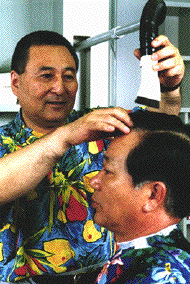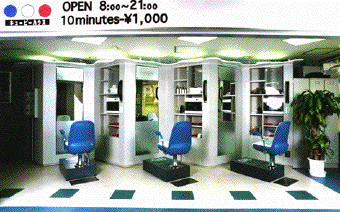
NO TIME TO KILL:
Market Embraces Faster Products, Services
OCTOBER 31, 1996

As the Japanese economy becomes more service oriented, people's use of time is diversifying. The increase in service-sector jobs means that working hours are no longer strictly nine-to-five; more people are working at night and on weekends.
In response to this trend, department stores and other retailers, restaurants, and movie theaters are adjusting their hours, giving people more flexibility in how they spend their time.
The Leisure Development Center in Tokyo predicts that the service sector will become increasingly polarized over the next several years; at one end will be services to satisfy customers' every whim and fancy for comfort and relaxation, and at the other will be businesses pursuing convenience, speed, and efficiency.
Offering services that answer the diversifying time demands of consumers will be the big challenge for companies in the service sector in the years to come.
Washing Away the Hours
One of the most time-saving appliances to hit the market over the past few decades is the automatic washing machine. Market surveys indicate, however, that homemakers now think the cycles take too long. Washing is performed nearly daily in many households, and several washings are done depending on how dirty the clothes are and what materials they are made of.
So manufacturers are focusing their efforts on building washing machines with shorter cycles and are emphasizing in their advertisements that the new machines leave more time free for the kids, for part-time work, and for hobbies.
The many new models hitting the stores in anticipation of demand from newlyweds (autumn being a popular wedding season) and the end-of-year sales offensive are selling their speed. One means of shortening the wash is to feed the water into the drum faster, which one manufacturer accomplished by improving the feed valve.
Other improvements include drums that can be filled with and emptied of water simultaneously during the washing and rinsing cycles and those that have pockets to allow delicate items like blouses to be washed along with other items.
Quick Massages
The massage industry was one of the first to restructure its services in accordance with customers' shifting time demands; shops offering quick massages began to appear about two years ago.
The traditional massage establishment was located outside a commercial district or in a residential area and offered a full-body massage with the client lying on a table or bed. The basic charge for a 60 minute session was around 5,000 yen (around 45 dollars at 110 yen to the dollar).
With the speeded-up service, only the upper body is massaged with the person fully dressed and seated. The cost has also been slimmed down to 1,500 yen (about 14 dollars) for 15 minutes.
These speedier establishments have been opening in such central districts of Tokyo as Shinbashi, Akasaka, and Shibuya, and they have proved to be popular with female office workers, who drop in during lunch break or on their way home to refresh themselves after hours in front of a computer screen. Male workers are also visiting the shops in growing numbers, and some establishments boast 200-300 customers a day. New branches are opening in department stores, and competition is heating up.
Barbers Trim Their Services

The needs of busy businessmen who want quick, no-frills haircuts are being met by a chain of barber shops offering 10-minute cuts for 1,000 yen (around 9 dollars). One such shop is opening in November in the fashionable shopping district of Ginza in central Tokyo.
The shop will have floor space of only around 20 square meters and seats for three people. The only service offered will be a haircut; customers will not get a shave or have their hair washed. Instead of the washing sink, each seat has a vacuum-cleaning device to remove cut hair.
To keep costs down, chairs are of simple style. Towels, combs, and other items will be disposable to eliminate the need to wash them. And an in-shop vending machine will issue 1,000-yen tickets, freeing the employees from the need to handle cash.
Streamlining to this degree contrasts starkly with normal practice at Japanese hairdressers, where customers usually get a cut, shampoo, and shave--all of which take a full hour. With the bill between 3,000 yen and 4,000 yen (between around 36 dollars and 45 dollars), shops also a offer light massage of the upper body, ear-cleaning, and other services.
The speedier shop will cater to the needs of the businessman who cannot slip out of the office for an entire hour to get his hair dressed.
The operators of the quick-snip shop are confident of success. They note that men can do the shaving and shampooing themselves and only need help with hair-cutting; if their service is inexpensive and speedy enough, the store can be certain of steady sales. People will still expect to appeal to a wide range of customers, including businessmen who want to spruce themselves up before an important business meeting or date.
There already are many barbers offering cheap and quick services--although they may not be as quick as the no-frills shop. While customers may welcome cheaper, faster cuts, they probably would not want to use such services all the time. They would still appreciate the leisurely approach of a regular barber from time to time. So there will no doubt continue to be work for the traditional barber as well.